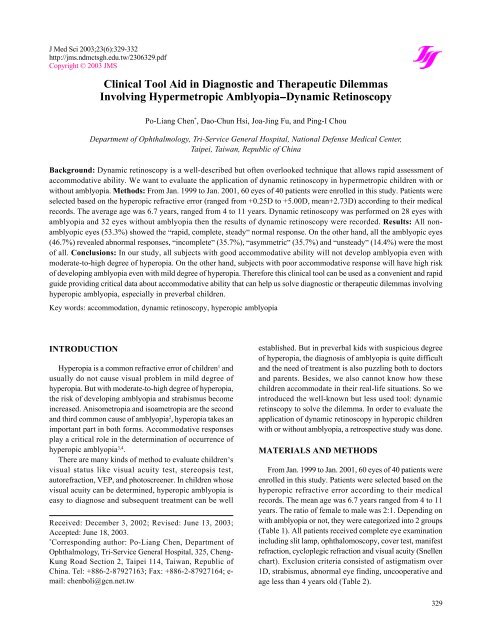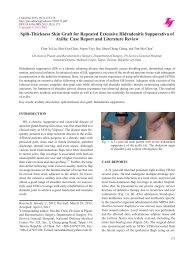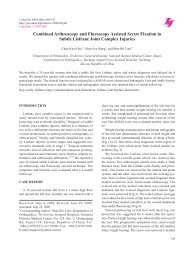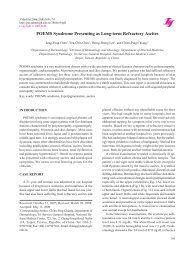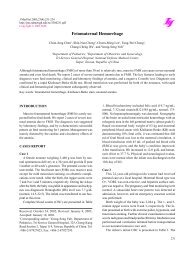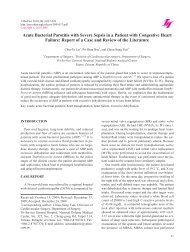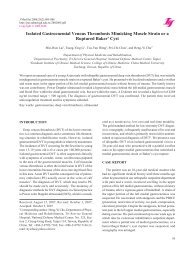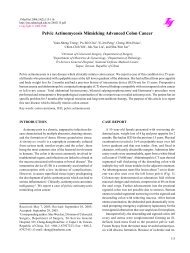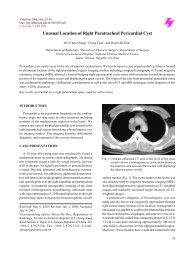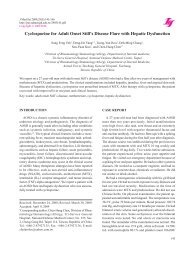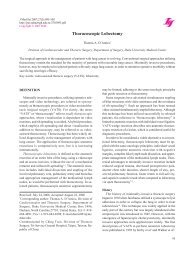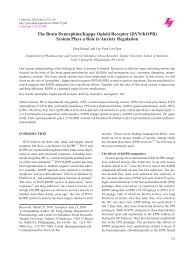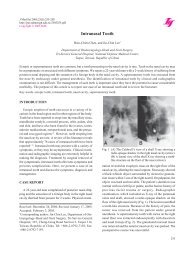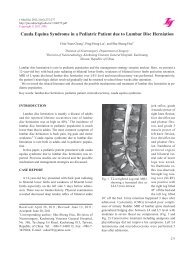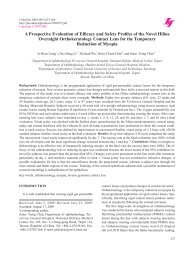Dynamic Retinoscopy
Dynamic Retinoscopy
Dynamic Retinoscopy
Create successful ePaper yourself
Turn your PDF publications into a flip-book with our unique Google optimized e-Paper software.
J Med Sci 2003;23(6):329-332<br />
http://jms.ndmctsgh.edu.tw/2306329.pdf<br />
Copyright © 2003 JMS<br />
Clinical Tool Aid in Diagnostic and Therapeutic Dilemmas<br />
Involving Hypermetropic Amblyopia--<strong>Dynamic</strong> <strong>Retinoscopy</strong><br />
Received: December 3, 2002; Revised: June 13, 2003;<br />
Accepted: June 18, 2003.<br />
* Corresponding author: Po-Liang Chen, Department of<br />
Ophthalmology, Tri-Service General Hospital, 325, Cheng-<br />
Kung Road Section 2, Taipei 114, Taiwan, Republic of<br />
China. Tel: +886-2-87927163; Fax: +886-2-87927164; email:<br />
chenboli@gcn.net.tw<br />
Po-Liang Chen * , Dao-Chun Hsi, Joa-Jing Fu, and Ping-I Chou<br />
Department of Ophthalmology, Tri-Service General Hospital, National Defense Medical Center,<br />
Taipei, Taiwan, Republic of China<br />
Po-Liang Chen, et al.<br />
Background: <strong>Dynamic</strong> retinoscopy is a well-described but often overlooked technique that allows rapid assessment of<br />
accommodative ability. We want to evaluate the application of dynamic retinoscopy in hypermetropic children with or<br />
without amblyopia. Methods: From Jan. 1999 to Jan. 2001, 60 eyes of 40 patients were enrolled in this study. Patients were<br />
selected based on the hyperopic refractive error (ranged from +0.25D to +5.00D, mean+2.73D) according to their medical<br />
records. The average age was 6.7 years, ranged from 4 to 11 years. <strong>Dynamic</strong> retinoscopy was performed on 28 eyes with<br />
amblyopia and 32 eyes without amblyopia then the results of dynamic retinoscopy were recorded. Results: All nonamblyopic<br />
eyes (53.3%) showed the “rapid, complete, steady” normal response. On the other hand, all the amblyopic eyes<br />
(46.7%) revealed abnormal responses, “incomplete” (35.7%), “asymmetric” (35.7%) and “unsteady” (14.4%) were the most<br />
of all. Conclusions: In our study, all subjects with good accommodative ability will not develop amblyopia even with<br />
moderate-to-high degree of hyperopia. On the other hand, subjects with poor accommodative response will have high risk<br />
of developing amblyopia even with mild degree of hyperopia. Therefore this clinical tool can be used as a convenient and rapid<br />
guide providing critical data about accommodative ability that can help us solve diagnostic or therapeutic dilemmas involving<br />
hyperopic amblyopia, especially in preverbal children.<br />
Key words: accommodation, dynamic retinoscopy, hyperopic amblyopia<br />
INTRODUCTION<br />
Hyperopia is a common refractive error of children 1 and<br />
usually do not cause visual problem in mild degree of<br />
hyperopia. But with moderate-to-high degree of hyperopia,<br />
the risk of developing amblyopia and strabismus become<br />
increased. Anisometropia and isoametropia are the second<br />
and third common cause of amblyopia 2 , hyperopia takes an<br />
important part in both forms. Accommodative responses<br />
play a critical role in the determination of occurrence of<br />
hyperopic amblyopia 3,4 .<br />
There are many kinds of method to evaluate children’s<br />
visual status like visual acuity test, stereopsis test,<br />
autorefraction, VEP, and photoscreener. In children whose<br />
visual acuity can be determined, hyperopic amblyopia is<br />
easy to diagnose and subsequent treatment can be well<br />
established. But in preverbal kids with suspicious degree<br />
of hyperopia, the diagnosis of amblyopia is quite difficult<br />
and the need of treatment is also puzzling both to doctors<br />
and parents. Besides, we also cannot know how these<br />
children accommodate in their real-life situations. So we<br />
introduced the well-known but less used tool: dynamic<br />
retinscopy to solve the dilemma. In order to evaluate the<br />
application of dynamic retinoscopy in hyperopic children<br />
with or without amblyopia, a retrospective study was done.<br />
MATERIALS AND METHODS<br />
From Jan. 1999 to Jan. 2001, 60 eyes of 40 patients were<br />
enrolled in this study. Patients were selected based on the<br />
hyperopic refractive error according to their medical<br />
records. The mean age was 6.7 years ranged from 4 to 11<br />
years. The ratio of female to male was 2:1. Depending on<br />
with amblyopia or not, they were categorized into 2 groups<br />
(Table 1). All patients received complete eye examination<br />
including slit lamp, ophthalomoscopy, cover test, manifest<br />
refraction, cycloplegic refraction and visual acuity (Snellen<br />
chart). Exclusion criteria consisted of astigmatism over<br />
1D, strabismus, abnormal eye finding, uncooperative and<br />
age less than 4 years old (Table 2).<br />
329
<strong>Dynamic</strong> retinoscopy detecting hyperopic amblyopia<br />
Table 1 Characteristics of the patients<br />
Sex<br />
Male<br />
Female<br />
Age (year, mean SD)<br />
Refraction error<br />
(diopter, mean SD)<br />
Amblyopia (No)<br />
0-+1D<br />
>+1-+2D<br />
>+2-+3D<br />
>+3-+4D<br />
>+4D<br />
Total<br />
Table 2 Exclusion criteria<br />
Astigmatism 1D<br />
Strabismus<br />
Abnormal eye finding (Nystagmus, Congenital cataract, Coloboma of the optic<br />
nerve, other systemic associated anomalies)<br />
Age
complete, steady” normal response. On the other hand, all<br />
amblyopic eyes (46.7%) revealed abnormal responses;<br />
“incomplete” (35.7%), “asymmetric” (35.7%), and “unsteady”<br />
(14.4%) were the most of all (Table 3). “Incomplete”<br />
means that the neutralization only can be seen if<br />
moving near target backward. “Unsteady” means that<br />
neutralization only can be seen for a short period of time.<br />
“Asymmetric” means that one eye achieves the neutralization<br />
response but another eye cannot accomplish the<br />
response. In view of relationship between power degree of<br />
hyperopia and various abnormal responses, “incomplete”<br />
response correspond to the highest mean power degree of<br />
hyperopia (4.15D) followed by “asymmetric” (3.675D),<br />
“unsteady” (2.75D) and “sluggish” (2.25D) responses.<br />
When compared with mean refractive error of all patients<br />
(2.73D) by using unpaired t test, “incomplete” and “asymmetric”<br />
have more significant statistical difference than<br />
other responses (P
<strong>Dynamic</strong> retinoscopy detecting hyperopic amblyopia<br />
ity cannot be determined like preverbal children, mild<br />
mental retardation, and Down syndrome. We also learn<br />
that it can be used as a reliable and quick screening tool for<br />
potentially amblyopiagenic refractive error of hyperopia.<br />
After this study in our clinical practice, we used this tool to<br />
help us make decision in treating children with hyperopic<br />
error that would produce amblyopia in preverbal children.<br />
REFERENCES<br />
1. Moore B, Lyons SA, Walline J. A clinical review of<br />
hyperopia in young children. The Hyperopic Infant’s<br />
Study Group. THIS. J Am Optom Assoc 1999;70:215-<br />
224.<br />
2. Lambert SR, Booth RG. Amblyopis. In: Thomas AW,<br />
Thomas JL, eds. Basic and Clinical Science Course<br />
Section 6. San Franciso: American Academy of<br />
Ophthalmology, 1988:46-47.<br />
3. Leat SJ, Gargon J. Accommodation response in children<br />
and young adults using dynamic retinoscopy.<br />
Ophthal Physl Opt 1996;16:375-384.<br />
4. Fern KD. Visual acuity outcome in isometropic<br />
hyperopia. Optom Vis Sci 1989;66:649-658.<br />
5. Ingram BM, Walker C, Wilson JM, Arnold PE, Dally<br />
S. Prediction of amblyopia and squint by means of<br />
refraction at age 1 year. Br J Ophthalmol 1986;70:12-<br />
15.<br />
332<br />
6. Levartovsky S, Oliver M, Gottesman N, Shimshoni M.<br />
Long-term effect of hypermetropic anisometropia on<br />
the visual acuity of treated amblyopic eyes. Br J<br />
Ophthalmol 1998;82:55-58.<br />
7. Guyton DL, O’Connor GM. <strong>Dynamic</strong> retinoscopy.<br />
Curr Opin Ophthalmol 1991;2:78-80.<br />
8. Jackson TW, Goss DA. Variation and correlation of<br />
clinical tests of accommodative function in a sample of<br />
school-age children. J Am Optom Assoc 1991;62:857-<br />
866.<br />
9. Rosenfield M, Portello JK, Blustein GH, Jang C.<br />
Comparison of clinical techniques to assess the near<br />
accommodative response. Optom Vis Sci 1996;73:<br />
382-388.<br />
10. Locke LC, Somers W. A comparison study of dynamic<br />
retinoscopy techniques. Optom Vis Sci 1989;66:540-<br />
544.<br />
11. Nott IS. <strong>Dynamic</strong> skiametry, accommodation and<br />
convergence. Am J Physiol Opt 1926;6:490-503.<br />
12. Rouse MW, London R, Allen DC. An evaluation of the<br />
monocular estimate method of dynamic retinoscopy.<br />
Am J Optom Physiol Opt 1982;59:234-239.<br />
13. Garcia A, Cacho P. MEN and Nott dynamic retinoscopy<br />
in patients with disorders of vergence and<br />
accommodation. Ophthal Physl Opt 2002;22:214-220.


